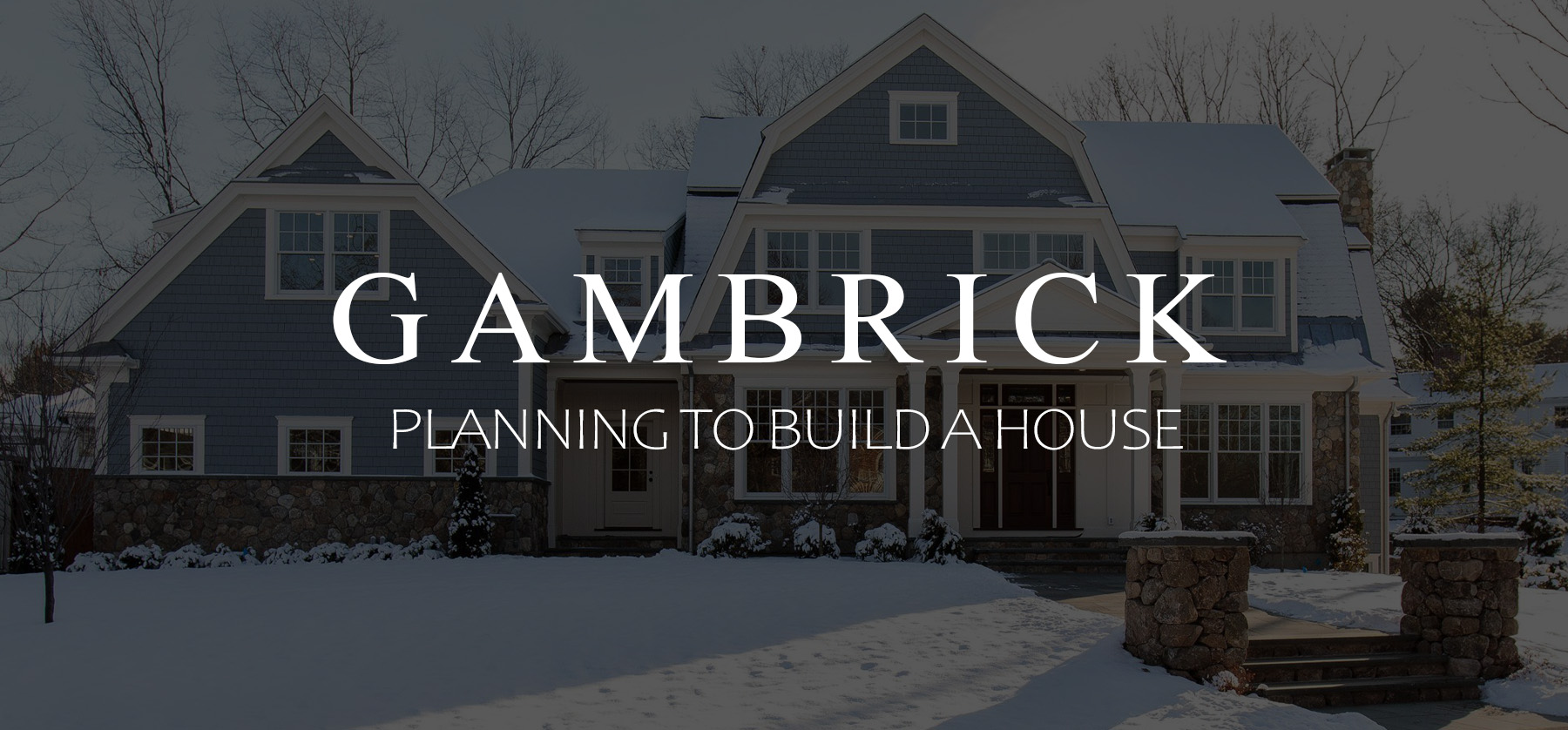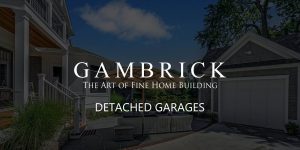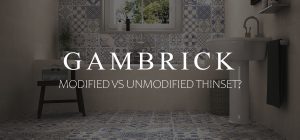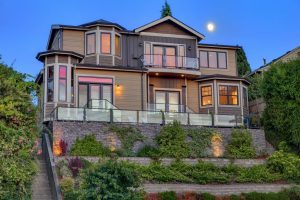Planning To Build A House
Whether your building your first home or the house you’ve always dreamed of, it can be a long and difficult process. Building a custom home isn’t like buying one that’s already built, every color, finish, design, size, shape, style and decision is up to you. If your planning to build a house there are some very important things you should consider before you get started.
Building a new home is similar to cooking dinner. If you want something average then go in the kitchen and quickly whip something up. But if you want to create a masterpiece then following a recipe and having a plan is a much better way of doing it. Success in the building business is all about planning. This may surprise you to hear, but some custom homes take more time to plan than they do to build. Site plans, architectural and engineering blue prints, floor plans, landscaping, color schemes, trim design, elevation drawings and a lot more. The finest homes plan out every detail before a single bit of field work is done.
For the average person planning to build a house, this level of detail probably won’t be needed. But everyone can benefit from some level of planning. There’s more to building a home then just telling an architect 3 bedrooms, 2000 sq. ft. and 2.5 baths. The style, colors, layout, materials and a hundred other details are all decided by you.
If your planning on building a home and want a smooth build that’s finished on time and on budget then there are a few things you should know. Below we’ll go through our steps to building a house checklist along with a bunch of tips and info.
Outline Your Overall Goals
Planning to build a house is all about setting goals and doing what’s needed to achieve those goals. The first step in the planning stage is drawing up an outline of the major things you want from the house. This is the planning stage from an overall perspective. Don’t start thinking about colors and finishes just yet.
At this point your plan outline should be about major things like how many bedrooms, bathrooms, square footage, the overall style of the home, how many stories, do you want a basement or garage, open floor plan or not, a dining room, etc. Define the major areas of the house.
This should also include the style of the home. Do you want a Colonial, Victorian, Ranch, Modern Farmhouse, etc. Home’s typically fall into a style category which guides a lot of the other choices that will come later. A planned style will also help guide the architect and other designers when it comes time to create a blueprint.
Another big part of this initial planning phase is the budget. Think about how much you’d ideally like to spend on the build. Remember that your build cost has nothing to do with permits, plans, land and other site work. You need a budget just for construction. In every area there tends to be a going rate where builders will stay close to unless you want something very custom. Find out what the going rate is and be realistic. If a 2000 sq. ft. home in your area costs $400,000 to build on average then don’t expect to build it for $300k.
Make A List
It’s important to plan and make a list of all the major elements you want in the house. Here’s a small checklist of thing to consider.
- How many beds & baths.
- Define the home’s style.
- Create a budget.
- Determine the size & stories.
- List the rooms. Family, dining, office etc.
- Do you want a garage, attic or basement.
- Open floor plan or not.
- List any special features you want included in the home.
If your hiring an architect to design a custom home for you then this list will help guide their work. It’s a reference point for designers to look at when making decisions about the house later on.
Plan
Spend as much time as possible in the planning stage. When your at home looking at example homes or drawing up a layout it doesn’t cost a thing. And on paper mistakes are easy to fix. I’ve seen way to many homeowners get in trouble because they started building too soon without a good plan.
When planning to build a new house spend extra time on the design phase. It’ll save you time and money later.
- Variations. Consider lot’s of variations to find what works best. You don’t want to build a house and say at the end “we should have done this or that.” Work out all the options and variables during the design and planning phase so you don’t have regrets later.
- Small Details. If your planning to build a house then be prepared to make lots of decisions. Consider every small details during the planning phase. Even tiny things like the style switch plate you’ll be using should be planned out. If you know which plate your using on day one then you can shop online and get a good deal on them. The same is true for every materials in the house. Planning will save you money because you can order in bulk and have time to negotiate.
- Layout. The floor plan is very important. Most people think too much about things like finishes and not enough on the function of the home. A good layout is very important to your day to day living.
- Options. For every finish get 2-3 options that will work from different price points. For example, if your building a Modern Farmhouse and love those light stained knotty floors you see in the pictures, get 2-3 samples from different manufacturers before you select one. Do this for all your finishes.
Proper planning of the home is very important if you want the best possible outcome and have a budget.
Site Plans
Aside from planning the house you’ll also need to put some time into the site plan. Planning to build a house isn’t just about the house itself, you’ll also need land which means a site plan. Here are a few things to consider.
- Driveway. You new home will need a driveway. How long will it be? How many cars wide? What will it be made of? Do you want a border?
- Sidewalk. Some areas require a sidewalk and some don’t you should find out in the planning phase.
- Fence. Contact the township if you plan on building a fence. There are probably rules as to how high you can build it, where and out of what material.
- Landscaping. This also include hardscaping. Most people eventually do something with the yard so you may as well put it into the plan right from the start.
- Exterior Amenities. A pool, outdoor kitchen, patio, decks, walkways, pool house, shed, detached garage or shade structure like a pergola should all be considered during the planning stages of building your new home.
All the work you want done on the property outside of the home should be included on the site plan.
Budget
While a budget should be a part of your list, it should be fleshed out and itemized right from the start. I tell clients to start considering the budget from the very moment you start thinking about building a house. Develop a realistic idea of how much you can afford to spend and how much the home you want will cost to build. This budget phase is all about balancing what you want to build with how much you can afford to spend.
One of the biggest mistakes I see clients make when building their first home is not working with a predetermined budget. They hire an architect and design the home of their dreams only to find out it costs way more to build then they can afford. Then they have to go back and have the plan re-worked. This costs time and wastes a lot of money. If you go to an architect with an outline for the home and a realistic budget you’ll save time and money.
When fleshing out your build budget, include everything that will go into the project. I like to work outside in just like we build a home. Include major elements first like excavation, foundation, framing, windows & doors, siding, gutters and the roof. Then work inside and price out electrical, HVAC, plumbing, insulation, drywall, flooring, paint, stairs, railings, trim, cabinetry, tile, fixtures, lighting, finishes.
I budget a house piece by piece and come up with a finish material budget room by room. Kitchens and baths are typically the biggest numbers.
How To Get Numbers
It’s not hard to find numbers for your budget. Just refer to your list and start calling subs or builders. It’ll be hard to get an exact number at this point since you don’t have a finished plan so ask them to give you a range.
If you just want to work with a builder e-mail them your list. They’ll be able to give you a square foot price to build based on a level of finish. The more info you can give them the better. Most builders in an area have a predetermined square foot price that they alter based on the finishes and final design of the home.
If you want to price each piece of the home or plan on being the GC yourself then start calling subcontractors. For example, call a few masons and ask for an estimate to build a foundation for a 2000 sq. ft. 2 story home with a 9 foot basement they’ll be able to give you a rough idea of the cost. Do the same for framers, electricians, plumbers, etc. All the subs I’ve ever worked with could give me a rough number with just a description of the work and then a final one they have plans.
Keep in mind the subcontractors are pricing out the work and sometimes the rough material. Finishes will be up to you to supply. For example a plumber will typically include all the piping but not the fixtures. Same with the electrician. You’ll be responsible for all your chandeliers, fans, pendant lighting, etc. Framers generally just price labor but they supply the nails. You supply the wood. Masons usually supply everything and give an all in quote.
Make sure to ask each sub what they include and what they don’t in their rough number.
Negotiate
Don’t forget to negotiate. One of the biggest mistakes I see homeowners who GC their own jobs make is not negotiating. Subcontractor bids and materials are negotiable. I rarely take anyone’s first bid when I’m building a home or doing any type of construction work. I also don’t buy materials at list price.
Did you know the just about every store selling finishes like lighting, cabinetry, countertops or plumbing all have negotiable pricing. Even big box stores like Home Depot will give you a better price if you order in bulk at the Pro Desk. This is where a good plan comes in handy.
If your planning to build a home then try to price out orders in bulk. You can save a lot of money on materials this way. And negotiate all the labor bids. Subcontractors will almost always give a homeowner a higher price than a builder because you probably won’t be giving them repeat business.
Extras
The cost of the land, local permit fees and taxes, design and engineering costs, landscaping, utilities, furniture and decorating, a fence, etc. There are going to be extra costs that have nothing to do with building the home or your builder. Make sure you include enough in your budget to cover them. I typically keep 2 budgets, one for building the home and one for the extras.
And don’t forget a contingency budget. Things rarely go exactly according to plan. There may be problems or changes that happen during the course of construction so you’ll need a little extra to cover things. In general most people try to have 5-10% extra just in case.
A spreadsheet program is a good way to draw up and keep a budget. Get one that auto corrects the total in case you have to go in and make changes along the way.
Loans
Chances are you’ll need a construction loan which becomes a mortgage when the home is done.Not every bank offers loans to build a new home and the rates and terms are a little different so do your research in the planning phase.
Find out how large a loan you can qualify for based on your income and other financial factors. There’s no sense creating a budget and then a set of blueprints if you can’t get the loan you need to pay for it all.
Most banks and other financial institutions will prequalify you for a construction loan but not all. Some banks have even frozen their construction loans due to Covid which may change depending on how things improve. You should call your local and a few national banks to find out because every State and County is a little different.
Prequalifying will give you a ballpark idea of the amount of money you can spend on everything which includes the land, construction and all the extras. Most banks will even do a market analysis for you to make sure what you plan to build makes sense for the area.
The bank will look at what different elements of your new home will cost to build. This includes the land, the architect or engineer, the builder who will manage the project, construction materials, appliances, finishes and interior features.Most banks will have an itemized outline for what things should cost which can help you flesh out your budget. Working with a bank can be a big help for first time home builders.
Budgeting Tips
Here are a few budget tips to keep in mind when planning to build a house.
- Don’t overbuild or borrow more money than you can afford. Banks are in the business of lending you the most money they can not in doing what’s best for you. That’s why it’s so important to set your own budget in the planning phase and then stick to it.
- Include for cost overruns. Most people budget in 5-10% for contingencies.
- Get multiple qualified bids. Part of the planning to build a new house is getting bids from builders or subcontractors. Get multiple bids for everything and remember to negotiate.
- Comparison shop for materials. This is the same as negotiating. Try to get a good deal on not only the labor but also materials.
- Land is the same as materials and labor. Make an offer. Unless the market is super hot and buyers are paying list or above, make an offer and negotiate.
- Negotiate with your bank too. Even a small percentage off will save money over a 30 year period.
- Buy in bulk. Almost every supplier will give you a discount on a bulk order. This is another benefit of good planning. If you know everything you’ll need in advance it makes it easier to price materials all at once.
Budgeting is an important part of planning to build a house. No matter how beautiful the house you design is, you still have to be able to pay for it.
Blueprints
A major step when planning to build a house is turning your vision into a reality. At some point you’ll need a set of blueprints that reflects your designs and wish list.
A blueprint includes the layout of the home, elevation views of the house from every side, and details on how to build it. It’s also got an electrical and plumbing layout. But there are tons of things that aren’t found in a blueprint. Stuff like the tile your using, trim, specific finishes, etc. Anything specific is left out. All the general stuff is included.
Make sure if your shopping online for plans that you buy a set that’s legal for the State your in. A New Jersey set of plans may need to be changed for California.
There are a few options when it comes to blueprints.
Stock
You can look online or go to an architect and buy a stock set of blueprints. This is the cheapest options because all the design work is already done. It’s basically just a print and stamp job for the architect. Sometimes they’ll do a review of the site to make sure the prints work for your lot but not always.
It’ll be hard to find a stock set that meets all your requirements but not impossible. If you find a set that has the perfect design then go ahead and use it. You’ll save a lot.
Custom
A custom set of plans can be very expensive because it involves design work. What I tell clients is to design as much of the house as possible by themselves. Tell the architect exactly what you want and show him with your own example pictures and a layout drawing. The more info you give the architect the better. With custom work your paying for the architects time so take as little up of it as you can.
Hybrid
Many clients find a stock set of plans that are 80%perfect and then change the 20% they don’t like. This is a sort of hybrid blueprint. It’s a great way to go. If you can find a set of plans to that just needs a few tweaks it could save you a bundle.
Location
Where do you want to build your new home?
Maybe you want a house with a great view, to live on a beach or somewhere near great schools. Whatever your priorities are you should list them all during the planning stage. This will help you determine a budget for land and narrow down an area.
To build a new home you’ll eventually need a place to build it. In some areas the land is so large that zoning issues aren’t a problem, but here in NJ they’re a big issue. If you have tight zoning regulations then it’s better to keep them in mind when designing the home. Here in NJ we have setbacks for the sides, front and rear along with a height restriction and a maximum amount of land we can build on. There are lots of rules so you need a zoning compliant house for the lot. However if you live in a State with large lots and less zoning rules it’s not as big an issue.
Land Options
A great option here in NJ is buying an old house and knocking it down to build a new one. We don’t have much vacant land so there isn’t much choice. If you have a similar issue then make sure to include the cost for demo and removal of the old house in your budget.
Large lots can often be wooded which means tree removal. Make sure to budget enough to clear the land and get it ready for construction.
Another issue with land is grading. This can be a problem no matter what the lot size is. No matter what size land you buy it could require some amount of grading or other site work. Make sure you look into this before buying the land or committing to build. Site work can be very expensive and can quickly destroy the budget.
Try to build in an area that’s increasing in value if you can. Land is a major part of a homes final value. And it’s one of the few things you can’t do anything about. Your home’s value will be determined to a large extent by where you build it. So try to build in the best area you can.
Special Requirements
Some land will have special requirements that you need to account for in your budget. An important part of planning to build a house is knowing all the factors that effect the build.
For example, here in NJ if you build by the beach you typically need wood pilings. The foundation is very different than if you built a home in land. There are also all sorts of hurricane codes that need to be followed and upgraded glazing. You have to be prepared for these additional costs.
Another issue is the soil makeup. Get a soil sample examined by an engineer. Here in NJ it costs around $350 bucks to get a soil sample bore done. We have some areas with bad soil which means a more expensive foundation. The last thing you want is to find out later you’ll need pilings or grade beams which adds thousands to the build price.
Flood prevention is also an issue if you live near or in a flood zone. You may need an elevated house, pilings or blow out walls.
Build A Team
There’s no way to build a house entirely on your own. You’ll eventually need blueprints which means an architect. You’ll need land which typically involves a realtor. If you need a loan that means a banker. Sourcing materials can be much easier if you work with a rep at a local building supply. And for the actual building part you’ll need lots of subcontractors.
While you might want to go it alone, assembling a team of professionals can be a big help. Especially if it’s your first time planning to build a house. There are dozens of factors we won’t be able to go over here and local concerns that local pros will know about.
- A good builder is the most important team member you’ll hire. Unless your acting as your own GC the builder is the boss and runs the job. He’ll generally hire all his own subs and oversee the entire build. Finding a good builder is a huge benefit, although it’s not a cheap one. Top builder command a high price tag for their work.
- The architect draws the blueprints for the house. Here in NJ they can also design the structure.
- An engineer may be needed to designs structural systems if your building something too custom for the architect to handle.
- Subcontractors will be needed for each trade.
- Interior designers and exterior designers like a landscape architect can be brought onto the team as needed.
I like to build the team early. Even if I don’t actually hire a sub until I need them I like to know who I’ll be using. If I have questions then I always have a Pro I can call to get the answer.
How Involved Will You Be?
An important questions to answer when planning to build a house is how involved you want to be with it’s design and construction.
While most homeowners hire an architect to design the home and a builder to build it, you can do most of the work yourself. I’ve worked with many homeowners who designed every inch of their home and only used an architect to draw the plans. No matter how much designing you do you’ll still need an architect to draw up and stamp the blueprints. And I’ve worked with lots of homeowners who acted as their own GC.
In this case you will be hiring and supervising all the subcontractors yourself. You’ll also be responsible for the finished product and you’ll have to carry the insurance for the job. Securing the site will also be your responsibility.
If you design the home then any mistakes are your own. Designing and building a custom home isn’t easy to do, but if your up to it, you could save a lot of money.
Other homeowners don’t want to do a thing. They hire an architect to design the house based on their outline and a builder to build it. It’s a much simpler process but it’s also a lot more expensive.
Contracts
Be sure to get written, signed contracts for each member of the team involved in building your home. At the very least, this means a contract with the builder and the architect. Hiring a builder makes it a little easier because he’ll take care of hiring each subcontractor and buying the materials.
If your the GC then make sure you get a real contract for each sub and check their insurance. Do everything legal, pay with a check and don’t hand out cash.
I don’t want to go into specific contract terms and conditions here. If you need help with this you should talk with a local lawyer. But I will say it’s super important to do your research and hire good people. These are the guys that will actually build your home so you have to trust and rely on them to do good work.
Adapt
You’ve spent tons of time planning to build your new home, went over all the checklists and done your negotiating. Permits are finally done, you’ve got the money secured and now it’s time to get started on the physical work. Is the hard part behind your or up ahead?
Oddly enough, it depends on how experienced you are and how flexible. Being able to adapt to issues is an important part of building the home. No matter how much time you spend planning to build your new home there will still be problems that are out of your control. How you and your team react to these issues is very important.
I recommend staying calm and working with your team to address any problems as they arise. This is where having the right team in place can be a huge benefit.
Some Common Issues
Here are a few common issues that tend to pop up of just about every job.
- Weather. There’s nothing you can do about it. If your in the middle of pouring a foundation and it rains for a week then you don’t pour. There’s not much you can do about the weather. But you can plan ahead if you live in an area with predictable seasons. Here in NJ I know every year when it tends to get cold, hot, or rain a lot. I try to plan around weather as much as possible.
- Materials. Prices of raw materials fluctuate a bit. Lumber and concrete are always changing and can effect the final cost if you priced a job out but didn’t order material for a year. Finish materials change and sometimes go out of stock. You may have picked the perfect tile during the planning phase but when it comes time to do the work found out that it’s out of stock. You need to adapt quickly.
- Sickness. I would never have though this would be an issue but these days it is. Depending on what happens with the current Covid situation things can change a lot very quickly. There’s not much you can do about it expect to create as safe a work environment as you can. We switched to using only small crews far apart and one at a time.It slowed things down but kept everyone safe and healthy.
- Inspections. When you build a home there are inspections. Some times they come out in a day and sometimes it takes them 2 weeks. You just have to deal with it the best you can and adapt your schedule around theirs.
Tips For A Smoother Build
- Don’t change your mind. Make all of the decisions during the planning phase and stick to them. Don’t change your mind or design as you go. This creates issues. Changes take time, waste money and create stress and uncertainty.
- Stay Focused. Try to stay focused on the job your doing right now. It’s easy to get distracted by what’s coming up.
- Look Ahead. I know this may seam weird because I just wrote stay focused, but you do have to keep in mind what’s next. Just don’t let it distract you from what’s going on right now at the job site. The guys will need your support and decision making. Especially if you’re the GC.
Get Samples
For each room of the house I get material samples and make a collage. If you’ve ever watched any house flip shows on TV then you’ve seen it done.
I first find a picture or reference that I like and use it as inspiration. Right now I’m designing a Modern Farmhouse so there’s tons out there to look at. I’m ordering 2-3 samples for the flooring, trim, countertops, cabinetry, tile, paints, lighting, etc. I put them all together and see what works and what doesn’t. And I do this for every room.
This plays into the budgeting part of the planning phase. Since I get all my samples at the very beginning all my decisions are made before I even start working. This allows me to source materials and negotiate good prices months before I need the materials. I’m also able to get it on site before the guys need it so there are no delays. getting samples is an important part of planning to build a home.
Another big benefit of getting lots of samples when planning to build a house is it keeps things moving smoothly and on schedule. if your designing and making decisions as you go then you may be forced into choosing something that isn’t perfect. Get samples in advance, take your time and choose carefully. Then order materials as you need them. When homeowners choose materials at the last minute things can easily go wrong.
Taxes
Another very important thing to consider when planning to build a new home are taxes. Here in New jersey we pay some of the highest property taxes in the country. And it varies from county to county so you really need to find this out before building.
In New Jersey the average property tax rate is 2.4% while the national average is around 1%. I know many people with an average size home paying over $30 grand a year in taxes. North Jersey and anywhere near the beach is very bad in terms of taxes.
Keep in mind that your tax rate is based on the value of the finished home and not what you payed to build it. The construction cost has nothing to do with your tax rate or what you paid for the land. The tax office will access your property for what it’s worth when your all done and that’s what you pay taxes on.
Hidden Costs
There are a few things you should consider that are not that expensive on there own but do add up and should be included when you plan to build a new home. Here are a few that apply to NJ. These may or may not apply to where you live so do some local research.
- Permits. Here in NJ permits are very expensive. They’re based on a percentage of the cost to build plus a flat fee. When you build a house you need a full release which means zoning, building, electrical, HVAC, fire and plumbing. I’m sure by the time you read this they’ll figure out something else to charge us for. The average we pay to build a new house is around $15,000.
- Low Income Housing. For some reason the NJ government charges every person who builds a home a fee that goes to build low income housing. It was around $2,000 the last time I paid it.
- Garbage. Believe it or not, even if you don’t use it, the State makes you buy a garbage can before they’ll give you a CO to live in your new house. It’s crazy and costs a couple hundred bucks.
- Utilities. In some cases you have to pay some of the cost to run utilities to a new home. I’m dealing with this right now in Millstone running electrical and gas to a house that’s 1500 feet from the street. The total cost is around $25,000. This is something you’ll definitely want to account for.
- Septic & Water. If you have city water and sewer that’s great. But if not you’ll need well and septic. A new septic system is around $35,000 and the well will run around $5-10k.
- Drainage. Getting water away from the house is very important but not included in your build price since it’s not required. Here in NJ all we do is put a leader pointed away from the house with a base. I recommend underground drain pipes.
- Security. If you want a security system that’s extra. Even something as simple as a doorbell camera isn’t cheap.
Think of all the little things when planning to build a new house because they add up fast.
Summary: Planning To Build A House
Whether your building your first home or the house you’ve always dreamed of, it can be a long and difficult process. Building a custom home isn’t like buying one that’s already built, every color, finish, design, size, shape, style and decision is up to you. If your planning to build a house there are some very important things you should consider before you get started.
Building a new home is similar to cooking dinner. If you want something average then go in the kitchen and quickly whip something up. But if you want to create a masterpiece then following a recipe and having a plan is a much better way of doing it. Success in the building business is all about planning. This may surprise you to hear, but some custom homes take more time to plan than they do to build. Site plans, architectural and engineering blue prints, floor plans, landscaping, color schemes, trim design, elevation drawings and a lot more. The finest homes plan out every detail before a single bit of field work is done.
For the average person planning to build a house, this level of detail probably won’t be needed. But everyone can benefit from some level of planning. There’s more to building a home then just telling an architect 3 bedrooms, 2000 sq. ft. and 2.5 baths. The style, colors, layout, materials and a hundred other details are all decided by you.
If your planning on building a home and want a smooth build that’s finished on time and on budget then hopefully the info we discussed here will help.
If you have any questions or comments e-mail us any time. We’d love to hear from you.





















